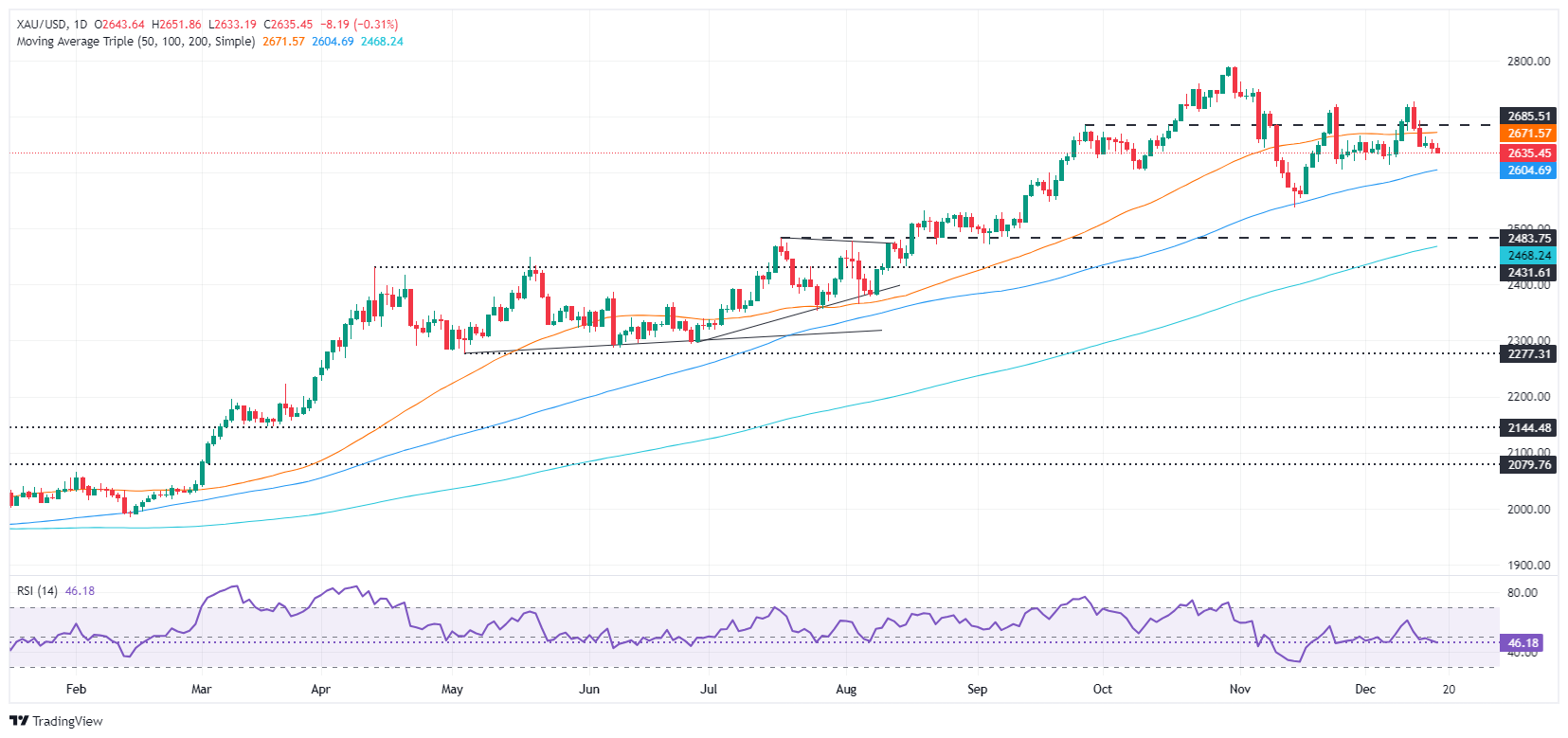
- Gold price declines sharply, trading between $2,600 and $2,610, as Fed’s less dovish outlook impacts the market.
- Federal Reserve Chair Jerome Powell emphasizes a prudent approach to monetary policy, with inflation risks still skewed to the upside.
- The Fed envisions a slow return to the 2% inflation target, projecting a timeline of one to two years.
- The latest dot plot from the Summary of Economic Projections reveals expectations for limited rate cuts through 2026, stabilizing the Fed funds rate at 3.4%.
Gold prices plummet as Federal Reserve Chair Jerome Powell takes a stance after the US central bank decided to cut rates. Projections suggest the Fed shifted less dovish. The XAU/USD trades around the $2,600-$2,610 range, about to fall beneath the former.
Federal Reserve Chair Jerome Powell indicated that the central bank may adopt a more cautious approach to future policy adjustments, noting that current measures are less restrictive. He emphasized that inflation risks and uncertainties remain tilted to the upside, partly explaining the dot plot changes.
Powell also projected that it could take one to two years for inflation to return to the 2% target while assuring that the labor market’s current state does not raise significant concerns about overheating.
The Federal Reserve cut rates by 25 basis points to the 4.25%-4.50% range, yet the decision was not unanimous, as Cleveland Fed President Beth Hammack opted to keep rates unchanged. When comparing the statement to the past meeting, there was little change, though traders were focused on the Summary of Economic Projections (SEP).
According to the SEP, the dot plot suggests that Fed officials see just two cuts for 2025 and two more for 2026. Officials estimate the Fed funds rate to end at 3.9% in 2025 and 3.4% in 2026.
Other projections suggest that the Fed’s favorite inflation gauge, the Core PCE, is expected to end at 2.8% in 2024, 2.5 % in 2025, and 2.2% in 2026. Regarding growth, the economy is foreseen to end at 2.5% in 2024, 2.1% in 2025, and 2% in 2026.
The Unemployment Rate is expected to end the current year at 4.4% and remain unchanged at 4.3% in 2025 and 2026.
After the data, gold prices plunged sharply as traders assessed the cut as hawkish, with just 100 basis points of easing for the next two years.
This week, investors will also focus on Thursday’s US GDP data and the Fed’s favorite inflation gauge, the core Personal Consumption Expenditures (PCE) Price Index, which could impact Bullion demand.
Daily digest market movers: Gold price tumbles after Fed’s decision
- Gold prices dropped as US real yields recovered, up by 7 basis points to 2.14%, a headwind for the precious metal.
- The US 10-year Treasury bond yield rises 5 basis points at 4.45% after Fed’s decision.
- The US Dollar Index, which tracks the performance of the American currency against six others, surges 0.70%% to 107.69.
- Building Permits in November rose by 6.1% MoM from 1.419 million to 1.505 million.
- Housing Starts for the same period fell -1.8% MoM from 1.312 million to 1.289 million.
- Recently released US Retail Sales data and Flash PMIs hint that the economy remains solid amid interest rates set above 4%. Although inflation edged lower, core prices stalling at 3% and headline inflation printing higher readings for three straight months suggest that inflation risks are skewed to the upside.
- The CME FedWatch Tool suggests that traders had priced in a 95% chance of a quarter-point rate cut on Wednesday.
- For 2025, investors are betting that the Fed will lower rates by 100 basis points.
Technical outlook: Gold price retreats, sellers eye 100-day SMA
Gold price remains upwardly biased, though it has remained trading sideways during the last three days, with no definitive direction. The golden metal trades within the $2,602-$2,670 area, capped by the 100 and 50-day Simple Moving Averages (SMAs), respectively.
For a bullish resumption, the XAU/USD must clear $2,650, followed by the 50-day SMA at $2,670. If surpassed, the next stop would be $2,700. Conversely, if XAU/USD drops below the 100-day SMA, the next support would be $2,600. If the price slips, the next support would be the November 14 swing low of $2,536, before challenging the August 20 peak at $2,531.
Fed FAQs
Monetary policy in the US is shaped by the Federal Reserve (Fed). The Fed has two mandates: to achieve price stability and foster full employment. Its primary tool to achieve these goals is by adjusting interest rates. When prices are rising too quickly and inflation is above the Fed’s 2% target, it raises interest rates, increasing borrowing costs throughout the economy. This results in a stronger US Dollar (USD) as it makes the US a more attractive place for international investors to park their money. When inflation falls below 2% or the Unemployment Rate is too high, the Fed may lower interest rates to encourage borrowing, which weighs on the Greenback.
The Federal Reserve (Fed) holds eight policy meetings a year, where the Federal Open Market Committee (FOMC) assesses economic conditions and makes monetary policy decisions. The FOMC is attended by twelve Fed officials – the seven members of the Board of Governors, the president of the Federal Reserve Bank of New York, and four of the remaining eleven regional Reserve Bank presidents, who serve one-year terms on a rotating basis.
In extreme situations, the Federal Reserve may resort to a policy named Quantitative Easing (QE). QE is the process by which the Fed substantially increases the flow of credit in a stuck financial system. It is a non-standard policy measure used during crises or when inflation is extremely low. It was the Fed’s weapon of choice during the Great Financial Crisis in 2008. It involves the Fed printing more Dollars and using them to buy high grade bonds from financial institutions. QE usually weakens the US Dollar.
Quantitative tightening (QT) is the reverse process of QE, whereby the Federal Reserve stops buying bonds from financial institutions and does not reinvest the principal from the bonds it holds maturing, to purchase new bonds. It is usually positive for the value of the US Dollar.


